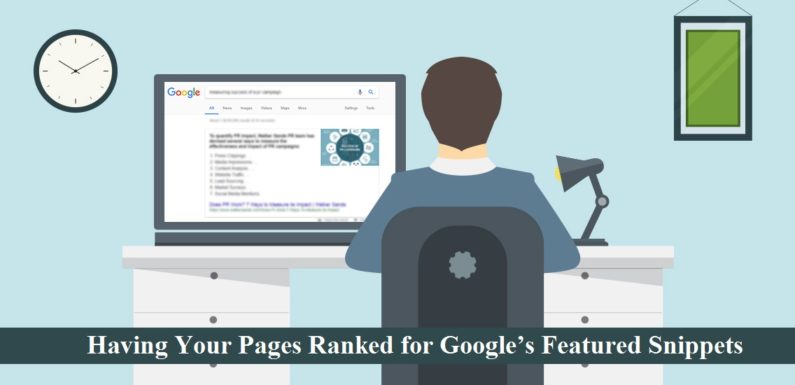
Having Your Pages Ranked for Google’s Featured Snippets
It‘s never been easier have an online presence. You could start your own website in no time, but that’s just half the task. The real work begins in having your website noticed amidst a sea of competition. There are many ways to get your site noticed though – one of which is having your page qualify as a featured snippet.
Featured snippets are a relatively new development on Google, and have so far been one of the most sought after SEO tools of the year. Featured snippets appear as answer boxes, which are the first results displayed after a query is made. As they appear first, they bear a type of seal that seemingly makes them the most desirable result. Features snippets have been observed to garner a substantial amount of clicks, and here’s why:
- They provide direct solutions to search queries
- They appear first, and as such are the most easily accessible
- They are given the space to provide more information than other results
- They appear to have Google’s approval
It is now evident that every brand should be focused on having their pages linked as featured snippets, but this is quite clearly going to be a difficult task. Only the top ranked pages are given the position as featured snippets and there are plenty of other sites competing for this same position.
Getting Your Pages Ranked for Snippets
According to Google, the only qualifying requirements for featured snippets are quality of content and its relation to queries. However, considering that only the top 10 ranked articles are actively considered for featured snippets, you realise the need for top class SEO.
SEO conscious organisations have been considering the benefits of having a webpage featured as a snippet for some time now. This is because it’s an almost instant guarantee of higher traffic, but then a page must already to meet certain standards, which include already achieving a high index rating. Elements that determine a high index rating include:
- Online traffic
- Quality content
- Backlinks
- Page Speed
- Mobile optimised pages
Organising Your Pages for Featured Snippets
1. Provide concise information
One of the main objectives and advantages of featured snippets is their ability to provide answers to the user, even before the pages are opened. When optimising a page for the featured snippets, it’s important to construct individual paragraphs in such a way that the answers they provide are immediately understood by the user. Secondary information and explanations should be placed in further paragraphs, where they can be accessed if the user needs them. If you use “call to actions” like ‘click here’, it should also contain information that the reader can readily use.
2. Use subheadings skillfully
Subheadings are your friend when it comes to ranking for snippets; by including a reasonable amount of subheadings, you’re able to clarify the areas of your webpage that provide answers for certain questions. This helps to focus web crawlers and users alike. The subheadings should (where possible) be phrased as questions, as this is very likely the way they will be required by Google users. Subheadings help to order a page properly and divide it into the most important points.
3. Organise efficiently
When creating content, it’s important to give factual answers that contain all the relevant details. This includes figures, links, images, tables and such required data. A favourite of featured snippets is displaying search answers in list form. This provides the information in optimal structure to users and is a time saving device. The extra details can then be explored by users who want to know them, by following the relevant link.
3. Structure articles to answer multiple related questions
It’s often the case that an article provides information about a particular topic, as well as many closely related topics. As such, this article is theoretically able to qualify as more than one possible solution for a search query. To illustrate: an article about the benefits of yoga will usually include information on the parts of the body affected by this activity as well. A well-structured article increases its chance of qualifying as a featured snippet, by expanding the range of topics covered.
4. Use quality keywords in your subheadings
Crawlers that determine the articles used in answer boxes certainly consider which keywords to use. There are several tools that help determine the best keywords that will qualify for a higher search ranking. In the case of answer boxes, the best keywords are often long-tail keywords, which are also findable with these tools. By using these, it’s possible to have your article qualify as answer boxes for more technical or specific queries. Research has concluded that most forms of featured snippets are found using long-tail keywords, as they clearly define the query.
5. Use eye-catching images
Most featured snippets will include an image. However, it’s not entirely clear how Google determines which images from an article will be included as a featured snippet. To account for this, it’s best to include attractive, relevant, and captivating images. These will grab the user’s attention, which will eventually account for SEO that attracts web crawlers in the long run. If your article is subsequently chosen as a featured snippet, these images will increase the likelihood of your pages being explored.
6. Check Google to find more questions
Under each answer box, there are usually other related questions listed – each of which when clicked will provide its own solutions. Some of these are easier to qualify for than others, due to their less common characteristics. Checking the related answer boxes will also provide you with ideas for content that will in future generate their own answer boxes.

